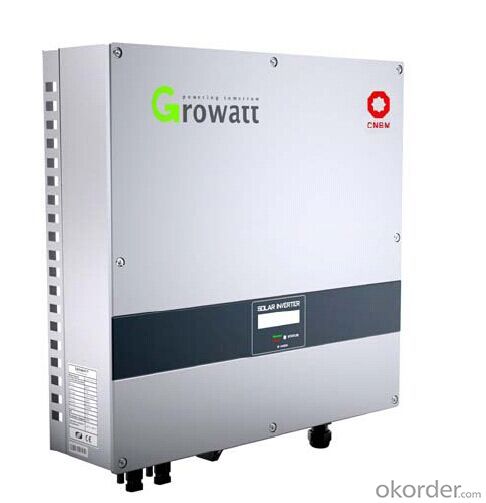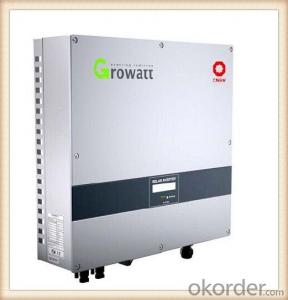Enphase Compatible CNBM-10000UE Grid-Tie Solar Inverter with Energy Storage Hybrid Solar Inverter
- Loading Port:
- China main port
- Payment Terms:
- TT OR LC
- Min Order Qty:
- 10000 watt
- Supply Capability:
- 100000 watt/month
OKorder Service Pledge
OKorder Financial Service
You Might Also Like
Introduction
CNBM-10000UE
CNBM-12000UE
CNBM-18000UE
CNBM-20000UE
Maximum efficiency of 97.9% and wide
input voltage range
Wide MPPT voltage
Internal DC switch
Transformerless GT topology
Compact design
MTL – String
Multi-MPPT
Certificate: CE, VDE 0126-1-1,
DK5940, G83/1-1, G59/2, RD1663,
EN50438, VDE-AR-N4105, CEI-021,
IEC-62109, ENEL-Guide, UL1741,
UL1998, IEEE1547, CSA
Warranty: 5/10 years
Features
Maximum efficiency of 97.9% and wide input voltage range
Internal DC switch
MTL-String
Bluetooth/RF technology /wifi
Transformerless GT topology
5 years warranty(10years as optional)
Images



Sepecification


FAQ
Q1: How to choose a right inverter?
A1:Tell us your demand, then our sales will recommend a suitable inverter to you.
Q2: What's the different between inverter and solar inverter?
A2: Inverter is only accept AC input, but solar inverter not only accept AC input but also can connect with solar panel to accept PV input, it more save power.
Q3: How about the delivery time?
A3: 7 days for sample; 25 days for bulk order.
Q4: What is the warranty of inverter?
A4: 5/10 years warranty on CNBM-Solar product.
Q5: How to solve the technical problem?
A5: 24 hours after-service consultancy just for you and to make your problem to solve easily.
- Q: How does a solar inverter handle grid frequency deviations?
- A solar inverter handles grid frequency deviations by constantly monitoring the grid frequency. When the grid frequency deviates from the standard range, the inverter adjusts its output frequency accordingly to match the grid frequency. This allows the inverter to maintain synchronization with the grid and continue injecting power efficiently, ensuring stability and reliability of the solar power system.
- Q: Can a solar inverter be used with batteries?
- Yes, a solar inverter can be used with batteries. In fact, many solar energy systems use a solar inverter to convert the DC (direct current) power generated by solar panels into AC (alternating current) power that can be used by household appliances. By integrating batteries into the system, excess solar energy can be stored for later use during periods of low sunlight or at night, providing a reliable and continuous power supply.
- Q: Can a solar inverter be installed outdoors?
- Yes, a solar inverter can be installed outdoors. However, it is important to ensure that the inverter is designed to be weatherproof and can withstand the elements. Additionally, proper ventilation and protection from direct sunlight should be considered when installing the inverter outdoors.
- Q: Three-phase photovoltaic inverter grid, the use of phase-locked loop is what?
- Photovoltaic inverters for grid-connected photovoltaic power generation systems are primarily capable of receiving DC power from photovoltaic arrays and converting them into sine-wave currents of the same frequency and in phase with the access grid for powering the grid or local loads.
- Q: Can a solar inverter be repaired or does it need to be replaced?
- A solar inverter can be repaired in many cases, depending on the extent of the damage or malfunction. However, in some situations, a replacement may be necessary if the damage is severe or the inverter is outdated.
- Q: Are solar inverters compatible with battery storage systems?
- Yes, solar inverters are compatible with battery storage systems. In fact, solar inverters play a crucial role in integrating battery storage with solar power systems. Solar inverters convert the direct current (DC) electricity generated by the solar panels into alternating current (AC) electricity that can be used to power our homes and businesses. Battery storage systems, on the other hand, store excess solar energy for later use, allowing us to use solar power even when the sun is not shining. When combined with solar inverters, battery storage systems can be charged using the excess energy generated by the solar panels during the day, and then discharge that stored energy during the night or during periods of high energy demand. To facilitate compatibility, solar inverters used in battery storage systems are equipped with additional features and functionalities. For example, they may have built-in charge controllers that regulate the charging and discharging of the batteries, ensuring their optimal performance and longevity. Additionally, advanced inverters may also include smart grid capabilities, allowing them to communicate with the utility grid and optimize energy flows based on grid conditions and electricity prices. Overall, solar inverters are essential components in ensuring the seamless integration of battery storage systems with solar power, enabling us to maximize the benefits of clean and sustainable energy.
- Q: How does the temperature affect the performance of a solar inverter?
- The temperature affects the performance of a solar inverter by influencing its efficiency and power output. Higher temperatures can cause the inverter to operate less efficiently, resulting in a decrease in its overall performance. This is because the semiconductor components in the inverter may experience increased resistance, leading to more power losses and reduced conversion efficiency. Additionally, excessive heat can also lead to thermal stress and component degradation, potentially impacting the long-term reliability and lifespan of the inverter.
- Q: Can a solar inverter be used with different solar panel brands?
- Yes, a solar inverter can generally be used with different solar panel brands as long as they have compatible voltage and power ratings. However, it is advisable to consult the manufacturer's specifications and guidelines to ensure optimal performance and compatibility.
- Q: What is the role of a solar inverter in reactive power compensation during grid disturbances?
- The role of a solar inverter in reactive power compensation during grid disturbances is to regulate and stabilize the flow of reactive power between the solar PV system and the grid. During grid disturbances, such as voltage fluctuations or power factor variations, the solar inverter can actively inject or absorb reactive power to maintain the voltage and power factor within acceptable limits. This helps in improving the overall stability and reliability of the grid system, ensuring efficient power transfer, and minimizing any adverse effects on the grid and connected electrical devices.
- Q: Can a solar inverter be used with solar-powered ventilation systems?
- Yes, a solar inverter can be used with solar-powered ventilation systems. A solar inverter is responsible for converting the direct current (DC) electricity generated by solar panels into alternating current (AC) electricity that can be used to power various appliances and devices, including ventilation systems. By connecting the solar panels to the solar inverter, the DC electricity produced by the panels can be converted into the appropriate AC voltage and frequency required for the ventilation system's operation. Thus, the solar inverter plays a crucial role in enabling the integration of solar power into ventilation systems.
Send your message to us
Enphase Compatible CNBM-10000UE Grid-Tie Solar Inverter with Energy Storage Hybrid Solar Inverter
- Loading Port:
- China main port
- Payment Terms:
- TT OR LC
- Min Order Qty:
- 10000 watt
- Supply Capability:
- 100000 watt/month
OKorder Service Pledge
OKorder Financial Service
Similar products
Hot products
Hot Searches
Related keywords


























